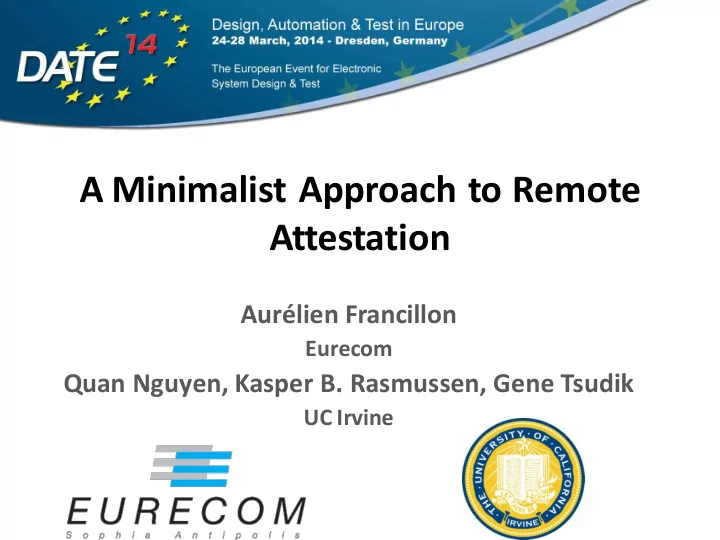

A Minimalist Approach to Remote Attestation Aurélien Francillon Eurecom Quan Nguyen, Kasper B. Rasmussen, Gene Tsudik UC Irvine
Overview • Motivation • Definition of Remote Attestation • From Definition to Properties • From Properties to Features • Conclusion 27-Mar-2014 Aurélien Francillon / EURECOM 1
Embedded Systems SmartCards Connected devices Sensors RFID Industrial systems 27-Mar-2014 Aurélien Francillon / EURECOM 2
Remote Attestation Remote attestation: • The act of remotely verifying the state of a device Requires guarantees that Prover is not lying 27-Mar-2014 Aurélien Francillon / EURECOM 3
Remote Attestation Examples Remote attestation can rely on: • Static root of trust (TPM, Secure boot, ...) – Only attests initial state of software • Dynamic root of trust (TXT, ARM TrustZone, SMART, ...) • Software-based attestation • Hybrids of the above (Sancus,..) Remote attestation is a popular field • Many publications and deployed systems • Some for tiny devices 27-Mar-2014 Aurélien Francillon / EURECOM 4
Remote Attestation Problem Lack of agreement about what is remote attestation and its required properties We define remote attestation and its minimum requirements. We then apply this to the case of: • Low-end microcontrollers: HW can be modified • Software attacks • Basic hardware interaction (not really hardware attacks) 27-Mar-2014 Aurélien Francillon / EURECOM 5
The Definition An attestation protocol P = (Setup, Attest, Verify): • k = Setup(1 κ ) a setup procedure to generate a shared key • α = Attest(k, s) Key, Device state => Attestation token • verdict = Verify(k, s’, α) Key, Expected state, Token => Yes/No 27-Mar-2014 Aurélien Francillon / EURECOM 6
Remote Attestation
The Att-Forgery Game We define game, as: • Prover has q attempts to generate states that differ from its real state and submit them to Attest() oracle • Eventually returns an α to the verifier Game outputs 1 iff Verify(k, s, α) = 1 The protocol is Att-Forgery-secure if: • Probabilistic polynomial time prover Prov • Large enough κ 27-Mar-2014 Aurélien Francillon / EURECOM 8
Requirements and Attacks From the definition we see that • Only attest can compute α • α = Attest(k, s) captures the device state This leads to 2 attack types • Adversary knows k, simulates attest, computes α • Returned α does not correspond to prover’s actual state 27-Mar-2014 Aurélien Francillon / EURECOM 9
Properties • Exclusive Access – Only Attest(k,s) , can access k • No Leaks – Only α should depend on k – No side channels or information leakages • Immutability • Un-interruptibility • Controlled Invocation 27-Mar-2014 Aurélien Francillon / EURECOM 10
From Properties to Features • High-level properties Features • Features are implementation choices and constraints. We chose them so as to: – Have minimal impact on the system – Be necessary and sufficient to guaranty security properties • However we claim minimality of properties, which are design independent, not Features 27-Mar-2014 Aurélien Francillon / EURECOM 11
Features • Key: Hardware protection from software access • No Leaks – Memory erasure, side-channel resistance? • Immutability – Attest code resides in ROM • Uninterruptibility – Attest is atomic, IRQ disabled… • Controlled Invocation – Execution only from valid entry points, hardware support 27-Mar-2014 Aurélien Francillon / EURECOM 12
Conclusion In-depth systematic treatment of remote attestation, from which we derived: • definitions and global security goals • derived properties • which are mapped into required features Helps identify limitations and shortcomings of current designs: • Many attacks discovered by checking manually • See long version of the paper Future work • perform formal verification / proofs of real systems 27-Mar-2014 Aurélien Francillon / EURECOM 13
Conclusion Questions ? 27-Mar-2014 Aurélien Francillon / EURECOM 14
Extra slides 27-Mar-2014 Aurélien Francillon / EURECOM 15
Minimality of properties • Exclusive Access – If adversary learns key, • No Leaks – Information about k • Immutability – Changing the code could be fatal • Uninterruptibility – Moving malicious code during attestation • Controlled Invocation – Invoking attest by skipping parts of it 27-Mar-2014 Aurélien Francillon / EURECOM 16
Recommend
More recommend